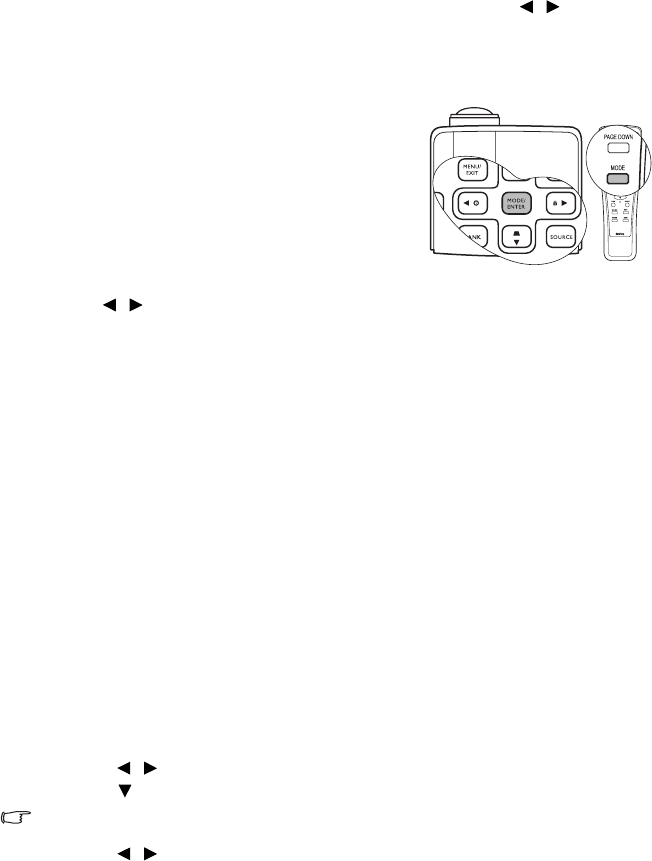
Operation32
Optimizing the image
Optimizing the imageOptimizing the image
Optimizing the image
Using Wall Color
Using Wall ColorUsing Wall Color
Using Wall Color
In the situation where you are projecting onto a colored surface such as a painted wall which
may not be white, the Wall Color feature can help correct the projected picture’s colors to
prevent possible color difference between the source and projected pictures.
To use this function, go to the DISPLAY
DISPLAYDISPLAY
DISPLAY > Wall Color
Wall ColorWall Color
Wall Color menu and press / to select a
color which is closest to the color of the projection surface. There are several precalibrated
colors to choose from: Light Yellow
Light YellowLight Yellow
Light Yellow, Pink
PinkPink
Pink, Light Green
Light GreenLight Green
Light Green, Blue
BlueBlue
Blue, and Blackboard
BlackboardBlackboard
Blackboard.
Selecting a picture mode
Selecting a picture modeSelecting a picture mode
Selecting a picture mode
The projector is preset with several predefined picture
modes so that you can choose one to suit your
operating environment and input signal picture type.
To select an operation mode that suits your need, you
can follow one of the following steps.
• Press Mode/Enter
Mode/EnterMode/Enter
Mode/Enter on the projector or remote
control repeatedly until your desired mode is
selected.
• Go to the PICTURE
PICTUREPICTURE
PICTURE >
> >
> Picture Mode
Picture ModePicture Mode
Picture Mode menu and
press / to select a desired mode.
1. Dynamic
DynamicDynamic
Dynamic mode
mode mode
mode: Maximizes the brightness of the
projected image. This mode is suitable for environments where extra-high brightness
is required, such as using the projector in well lit rooms.
2. Presentation
PresentationPresentation
Presentation mode (Default)
mode (Default) mode (Default)
mode (Default): Is designed for presentations. The brightness is
emphasized in this mode to match PC and notebook coloring.
3. sRGB
sRGBsRGB
sRGB mode
mode mode
mode: Maximizes the purity of RGB colors to provide true-to-life images
regardless of brightness setting. It is most suitable for viewing photos taken with an
sRGB compatible and properly calibrated camera, and for viewing PC graphic and
drawing applications such as AutoCAD.
4. Cinema
CinemaCinema
Cinema mode
mode mode
mode: Is appropriate for playing colorful movies, video clips from digital
cameras or DVs through the PC input for best viewing in a blackened (little light)
environment.
5. User 1
User 1User 1
User 1/
//
/User 2
User 2User 2
User 2 mode
mode mode
mode: Recalls the settings customized based on the current available
picture modes. See "Setting the User 1/User 2 mode" on page 32 for details.
Setting the
Setting the Setting the
Setting the User 1
User 1User 1
User 1/
//
/User 2
User 2User 2
User 2 mode
mode mode
mode
There are two user-definable modes if the current available picture modes are not suitable
for your need. You can use one of the picture modes (except the User 1
User 1User 1
User 1/2
/2/2
/2) as a starting point
and customize the settings.
1. Press Menu/Exit
Menu/ExitMenu/Exit
Menu/Exit to open the On-Screen Display (OSD) menu.
2. Go to the PICTURE
PICTUREPICTURE
PICTURE > Picture Mode
Picture ModePicture Mode
Picture Mode menu.
3. Press /
//
/ to select User 1
User 1User 1
User 1
or User 2
User 2User 2
User 2.
4. Press
to highlight Reference Mode
Reference ModeReference Mode
Reference Mode.
This function is only available when User 1 or User 2 mode is selected up in the Picture Mode
sub-menu item.
5. Press /
//
/ to select a picture mode that is closest to your need.
